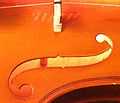Shoulder rest

The shoulder rest is an accessory that can be found on violins and violas. It may be made of wood, aluminium, carbon fiber or plastic. Usually, the shoulder rest attaches to the edge of the back of the violin with "feet" padded with rubber tubing or made of soft plastic. The goal of a shoulder rest is to allow a more comfortable attitude while playing by adding height to the shoulder and preventing the instrument from slipping (Kreitman, p. 30). A shoulder rest generally follows the curve of the shoulder; some shoulder rests are bendable, others are made of sponge-like material, and a few have an extension that hooks further over the shoulder for stability. It is a relatively recent invention, and though it is quite commonly used among modern violinists and violists, it is not universally used. Depending on body type and style of clothes, some musicians need no more than a thin sponge, a cloth or sometimes nothing at all under the instrument.
Merits and Demerits
There are two common approaches to playing without a shoulder rest. The first is to hold the violin horizontal with the support of the left hand at all times. This usually decreases the mobility of the thumb during downshifts and requires the thumb never to leave the neck of the violin in order to support the instrument. The second approach is to support the instrument almost fully at the neck-shoulder region, often requiring the use of some form of padding beside the collar bone to bring the violin closer to the jaw and to hold the instrument in place. Some violinists may even raise their shoulder to achieve this, particularly when shifting positions and when using vibrato. Problems frequently surface while doing this, such as constant muscle tension which obstructs fluidity of technique, and may lead to injury in the long term. These problems can also arise from incorrect usage of shoulder rests.
A shoulder rest can dampen the instrument's tone by decreasing the vibrations of the back of the instrument. According to the renowned violinist and professor Leopold Auer, the use of a shoulder rest could take away more than one-third of the violin's natural volume; although more recent scientific studies prove it to be substantially less.[1] The shoulder alone can also hinder the instrument's tone if it is pressing against the back of the instrument. Many great violinists, including Tibor Varga, Aaron Rosand, Arthur Grumiaux, Anne-Sophie Mutter, David Oistrakh, Jascha Heifetz, Joseph Szigeti, Yehudi Menuhin, Henryk Szeryng, Ivry Gitlis, Mischa Elman, Nigel Kennedy, Nathan Milstein, Itzhak Perlman, Pinchas Zukerman, Michael Rabin, Fritz Kreisler, Efrem Zimbalist, Isaac Stern, and Eugène Ysaÿe have not used a shoulder rest.
Some instruments have been marked due to the friction on the wood and added tension to the instrument the shoulder rest may bring according to each different player strength.
A shoulder rest, whatever its design, is an accessory to facilitate holding the violin. This can lighten the task of the left hand, enabling smoother and lighter shifting technique. All rests must make a compromise between violin support and freedom (or flexibility in holding the violin). There are a number of soft rests (generally anatomy friendly) and harder or rigid rests on the market.
See also
References
- ↑ Maia Bang Violin Method, Part 1, Page 8
- Notes
- Kempter, Susan (2003). How Muscles Learn: Teaching the Violin with the Body in Mind. 15800 NW 48th Avenue, Miami, FL, 33014: Summy-Birchard Music, Warner Bros. Publications. pp. 23–28. ISBN 1-58951-401-7.
- Kreitman, Edward (1998). Teaching from the Balance Point. 1106 Chestnut Street, Western Springs, Illinois, 60558: Western Springs School of Talent Education. p. 30. Library of Congress Catalog Card Number 98-90294.
- Richard Ward (March 2005). "Show of Support: Choosing the right shoulder rest can be a tricky task". Strings (San Rafael, California, United States of America: String Letter Publishing) 127. Archived from the original on 2006-11-09.
| |||||||||||||||||||
